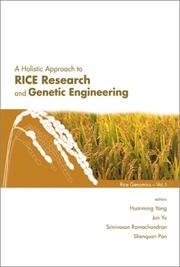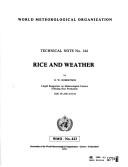| Listing 1 - 10 of 115 | << page >> |
Sort by
|
Dissertation
Year: 2017 Publisher: Liège Université de Liège (ULiège)
Abstract | Keywords | Export | Availability | Bookmark
 Loading...
Loading...Choose an application
- Reference Manager
- EndNote
- RefWorks (Direct export to RefWorks)
Le Programme d’Appui au Développement de l’Irrigation (PADI) a été développé dans l’optique d’optimiser la gestion de l’eau, en définissant quatre résultats répondant à des enjeux aussi différents que la Gestion Intégrée des Ressources en Eau (GIRE) le demande. Ici, nous nous sommes penchés sur la gestion de l’eau à usage agricole au niveau du sous bassin-versant de la Haute-Comoé, se situant dans la Région des Cascades. La réflexion qui a débuté en 2002 avec un précédent projet, le projet GE-eau, autour de cette problématique a débouché sur la mise en place d’outils de gestion. Ces derniers étaient destinés aux agents du Ministère de l’agriculture et des aménagements hydrauliques (MAAH), et plus précisément à ceux de la Direction Générale des Aménagements Hydrauliques et du Développement de l’Irrigation (DGAHDI) et de la Direction Régionale des Aménagements Hydrauliques et du Développement de l’Irrigation de la Région des Cascades (DRAAH), entre autres. A l’issu de la seconde phase du PADI, s’est posée la question de l’appropriation de ces outils par les agents. Le présent travail développe une réflexion autour de cette interrogation. Grâce à des entretiens menés auprès des agents de la DRAAH et de la DGAHDI, il ressort que le niveau d’appropriation reste somme toute faible (41% des personnes interrogées), avec un niveau plus important au niveau de la DGAHDI (56% des agents interrogés). La mobilité du personnel, l’inadéquation des activités et des formations suivies sont autant de raisons qui ont conduit à ce faible taux. Nous avons également mené des entretiens auprès des producteurs de notre zone d’études afin d’évaluer leurs besoins d’informations en matière d’irrigation. Il ressort de l’analyse que ce sont davantage des besoins pour l’agriculture en générale et non spécifiquement ceux liés au secteur de l’agriculture irriguée qui font défaut.
PADI --- Outils de gestion --- Irrigation --- Sciences du vivant > Agriculture & agronomie
Book
Year: 2001 Publisher: Bruxelles : Ministère des Classes Moyennes et de l'Agriculture,
Abstract | Keywords | Export | Availability | Bookmark
 Loading...
Loading...Choose an application
- Reference Manager
- EndNote
- RefWorks (Direct export to RefWorks)
Cereals --- Cereals --- Aphidoidea --- Aphidoidea --- Parasitoids --- Parasitoids --- Biological control --- Biological control --- Sitobion avenae --- Sitobion avenae --- Metopolophium dirhodum --- Metopolophium dirhodum --- Rhopalosiphum padi --- Rhopalosiphum padi
Book
ISBN: 0851985459 Year: 1985 Publisher: Kew Commomwealth mycological institute
Abstract | Keywords | Export | Availability | Bookmark
 Loading...
Loading...Choose an application
- Reference Manager
- EndNote
- RefWorks (Direct export to RefWorks)
Rice --- -Lowland paddy --- Lowland rice --- Oryza sativa --- Paddy (Plant) --- Padi --- Palay --- Oryza --- Diseases and pests
Book
ISBN: 9781107044395 9781107360266 9781107622371 1107360269 9781316204061 1316204065 1107044391 1107622379 1316191095 1316211444 1316189252 1316209555 1316205886 1316207692 Year: 2015 Publisher: New York, NY
Abstract | Keywords | Export | Availability | Bookmark
 Loading...
Loading...Choose an application
- Reference Manager
- EndNote
- RefWorks (Direct export to RefWorks)
Rice today is food to half the world's population. Its history is inextricably entangled with the emergence of colonialism, the global networks of industrial capitalism, and the modern world economy. The history of rice is currently a vital and innovative field of research attracting serious attention, but no attempt has yet been made to write a history of rice and its place in the rise of capitalism from a global and comparative perspective. Rice is a first step toward such a history. The fifteen chapters, written by specialists on Africa, the Americas, and Asia, are premised on the utility of a truly international approach to history. Each brings a new approach that unsettles prevailing narratives and suggests new connections. Together they cast new light on the significant roles of rice as crop, food, and commodity and shape historical trajectories and interregional linkages in Africa, the Americas, Europe, and Asia.
HISTORY / World. --- Rice --- History. --- Lowland paddy --- Lowland rice --- Oryza sativa --- Paddy (Plant) --- Padi --- Palay --- Oryza
Book
ISBN: 1281968072 9812814299 9789812814296 9812818685 9789812818683 9789812818683 9781281968074 Year: 2001 Publisher: Manila, Philippines International Rice Research Institute
Abstract | Keywords | Export | Availability | Bookmark
 Loading...
Loading...Choose an application
- Reference Manager
- EndNote
- RefWorks (Direct export to RefWorks)
The Rice Genetics Collection of past symposia and other selected literature contains nearly 4,400 pages of searchable information on rice genetics and cytogenetics published by the IRRI and its partners since 1964. In addition to the five genetics symposia held at 5-year intervals since 1985, the collection contains classic publications that kicked off significant reporting on these subjects in the early 1960's. This collection is a comprehensive and historical documentation on the subject of rice genetics, spanning 45 years of research and scholarly work. Published in 2000, Rice Genetics IV contains 31 chapters from various contributors on topics dealing with rice genetic research, including molecular markers, genetic diversity, and evolution; structural and functional genomics; gene isolation and function; and transformation.
Rice --- Lowland paddy --- Lowland rice --- Oryza sativa --- Paddy (Plant) --- Padi --- Palay --- Oryza --- Genetics --- Genetic engineering --- Yields

ISBN: 1281933872 9786611933876 9812791345 9789812791344 9812383506 9789812383501 9812382070 9789812382078 Year: 2003 Publisher: River Edge, N.J. : World Scientific,
Abstract | Keywords | Export | Availability | Bookmark
 Loading...
Loading...Choose an application
- Reference Manager
- EndNote
- RefWorks (Direct export to RefWorks)
The aim of this book series is to familiarize scientists, students and the general public with exciting new discoveries and developments in rice genomics. Leading scientists in rice genomics and related fields are invited to write articles in a cohesive format that appeals to both researchers and laypersons with an interest in genomics and biotechnology. The first volume provides the background information and highlights the major achievements in rice genomics; ongoing developments in this exciting field are also discussed. This volume promotes genomics as a holistic approach to rice research and genetic engineering.
Rice --- Lowland paddy --- Lowland rice --- Oryza sativa --- Paddy (Plant) --- Padi --- Palay --- Oryza --- Genetic engineering. --- Genetics.
Book
ISBN: 1838810323 1838810315 Year: 2021 Publisher: London, England : IntechOpen,
Abstract | Keywords | Export | Availability | Bookmark
 Loading...
Loading...Choose an application
- Reference Manager
- EndNote
- RefWorks (Direct export to RefWorks)
Rice --- Research. --- Lowland paddy --- Lowland rice --- Oryza sativa --- Paddy (Plant) --- Padi --- Palay --- Oryza
Book
ISBN: 1839696001 1839695994 Year: 2022 Publisher: London : IntechOpen,
Abstract | Keywords | Export | Availability | Bookmark
 Loading...
Loading...Choose an application
- Reference Manager
- EndNote
- RefWorks (Direct export to RefWorks)
Rice. --- Lowland paddy --- Lowland rice --- Oryza sativa --- Paddy (Plant) --- Padi --- Palay --- Oryza
Book
ISBN: 0860081346 Year: 1975 Publisher: [Tokyo] University of Tokyo Press
Abstract | Keywords | Export | Availability | Bookmark
 Loading...
Loading...Choose an application
- Reference Manager
- EndNote
- RefWorks (Direct export to RefWorks)
Rice --- Riz --- 633.18 <5> --- Rices. Oryza--Asia --- Lowland paddy --- Lowland rice --- Oryza sativa --- Paddy (Plant) --- Padi --- Palay --- Oryza

ISBN: 9263104239 9789263104236 Year: 1975 Volume: 144 423 Publisher: Geneva : Secretariat of the World Meteorological Organization,
Abstract | Keywords | Export | Availability | Bookmark
 Loading...
Loading...Choose an application
- Reference Manager
- EndNote
- RefWorks (Direct export to RefWorks)
Rice --- Climatic factors --- Rice. --- Climatic factors. --- Lowland paddy --- Lowland rice --- Oryza sativa --- Paddy (Plant) --- Padi --- Palay --- Oryza --- Rice - Climatic factors
| Listing 1 - 10 of 115 | << page >> |
Sort by
|

 Search
Search Feedback
Feedback About UniCat
About UniCat  Help
Help News
News